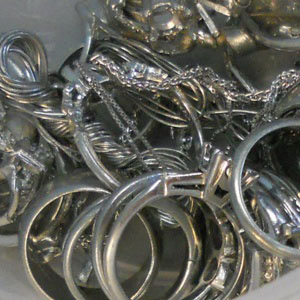5 Things You Need to Know about Recycling Platinum-Plated Jewelry
Platinum-plated jewelry has unique properties that are often misunderstood. If you own quantities of platinum-plated jewelry or platinum plate scrap, here is some critical information you need to know about recycling it . . .
1. Platinum-Plated Objects Must Be Refined, Not Reformed
Shown: Jewelry and jewelry scrap containing platinum and other platinum group metals like rhodium that our customers have sent in for recycling and refining.
Unlike karat gold, sterling silver and many other kinds of jewelry, platinum-plated items cannot be reworked or redesigned. Because the platinum has been applied as a plating, any attempt to heat, hammer or reshape a piece will result in a disastrous failure.
2. Platinum-Plated Rings Cannot Be Resized
Any attempt to stretch them a size larger will result in the same kind of catastrophic failure that we described just above. Plus, platinum –plated rings cannot be cut and remanufactured into smaller sizes. So if you have a number of platinum-plated rings on hand, you need to send them to a qualified platinum refinery like Specialty Metals Smelters and Refiners for recycling.
3. “Platinum Plated” Can Mean Many Things
It does sound like “platinum plated jewelry” can only be one kind of material. But in reality, platinum can be plated onto gold, silver, and even a soft metal like copper. Obviously, 100 pounds of platinum-plated silver jewelry will be worth much more than 100 pounds of platinum-plated copper items. The only way to know how much your items are worth is to send them for testing at an experienced platinum recycling company.
4. Platinum-Plated Jewelry Can Tarnish and “Turn Your Skin Green”
It is a myth that anything coated with platinum cannot tarnish. If the layer of platinum is too thin, it can wear away and expose the metal underneath. The result? An “untarnishable platinum-plated” piece of jewelry that tarnishes, changes color, or irritates your skin.
5. When You Look at Platinum-Plated Jewelry, You Might Not Be Seeing Platinum
Platinum-plated metals can sometimes be plated with an additional thin layer of rhodium, which is even harder and more corrosion-resistant than platinum itself. Sometimes this additional layer of rhodium has not been disclosed by the manufacturer, and the piece will only be labeled “platinum-plated.” How can you tell? You need the services of an expert platinum recycler like Specialty Metals Smelters and Refiners.
Call Specialty Metals to Learn More about Platinum-Plated Jewelry
Prices for platinum are on the rise, so you need to know all you can about recycling this precious metal. Call us at 800-426-2344 to learn more.
Related Posts:
How Much Platinum Does Your Platinum Jewelry Really Contain?
Six Traits of the Best Platinum Refiners
Platinum Sterling: What You Need to Know about this Precious Alloy
What Happens when Platinum Meets Rhodium?
An Invitation to Jewelers, Pawnbrokers and Other Jewelry Professionals to Partner with Our Precious Metals Refinery

